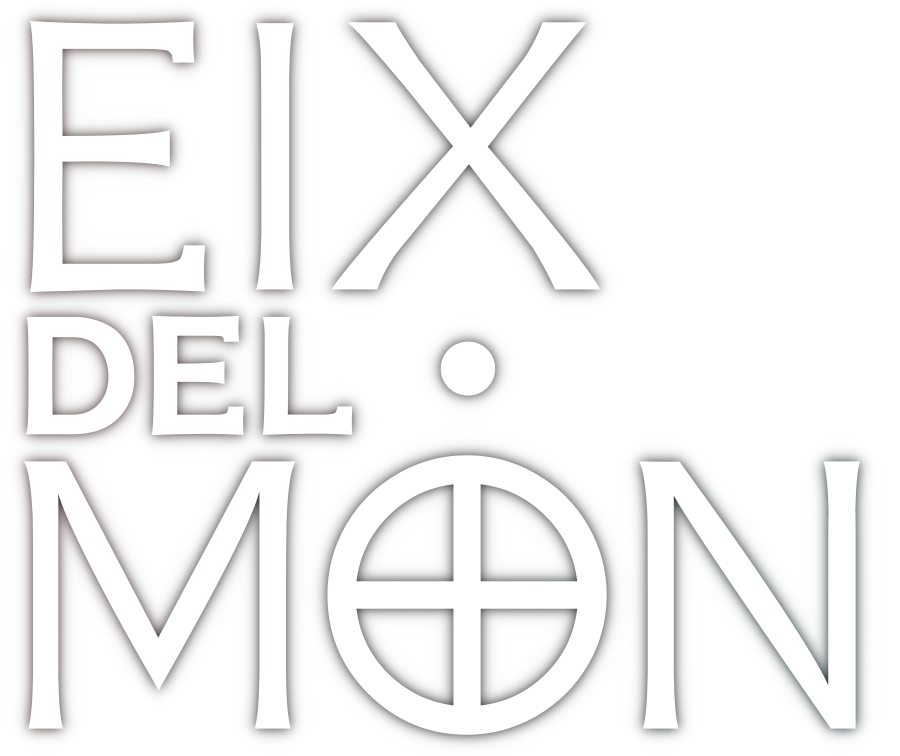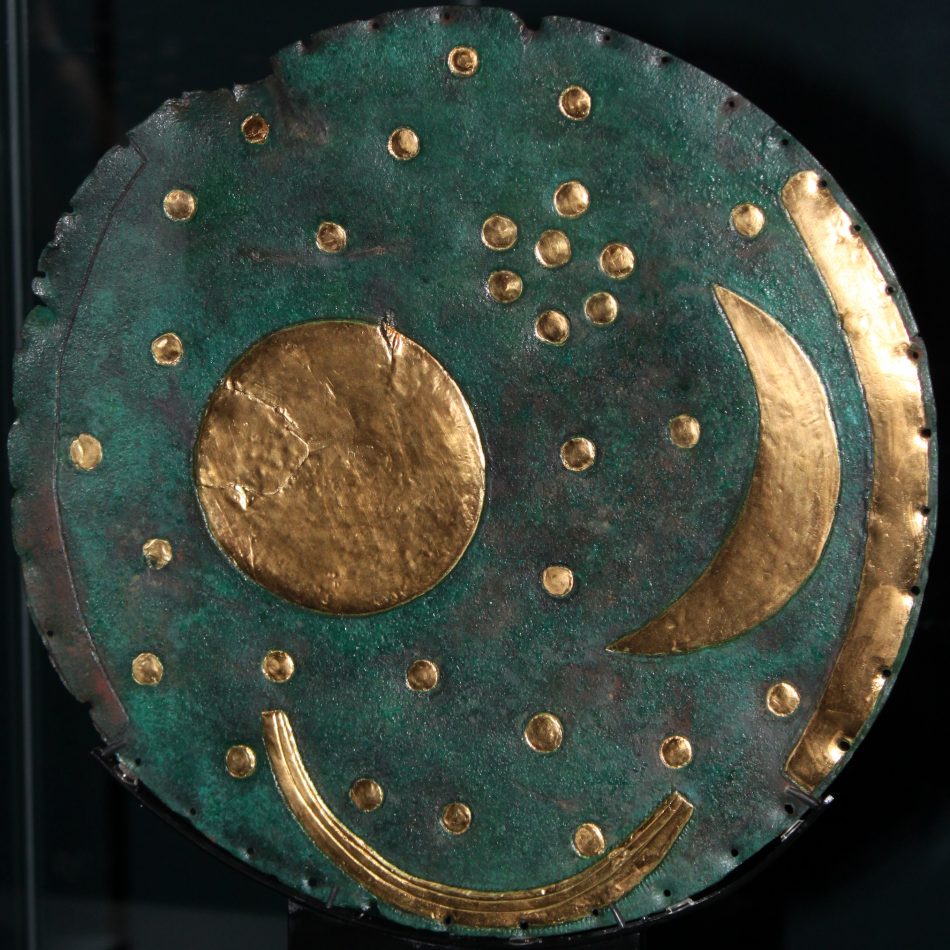The Nebra sky disk; Mittelberg near Nebra (Germany); Special exhibition “Beyond the Horizon – Space and Knowledge in the Old World cultures” at the Pergamon Museum (22.06 -. 30.09.2012). CC BY by Anagoria.
The Nebra sky disk is a bronze disk of around 30 centimetres (12 in) diameter and a weight of 2.2 kilograms (4.9 lb), with a blue-green patina and inlaid with gold symbols.
Wikipedia says:
The precise dating of the Nebra skydisk depended upon the dating of a number of Bronze Age weapons, which were offered for sale with the disk and said to be from the same site. These axes and swords can be dated typologically to the mid 2nd millennium BC. Radiocarbon dating of a birchbark particle found on one of the swords to between 1600 and 1560 BC confirmed this estimate. This corresponds to the date of burial, at which time the disk had likely been in existence for several generations.
-
![[DOI]](https://www.eixdelmon.com/wp-content/plugins/papercite/img/external.png) A. Ehser, G. Borg, and E. Pernicka, “Provenance of the gold of the Early Bronze Age Nebra Sky Disk, central Germany: geochemical characterization of natural gold from Cornwall,” , vol. 23, iss. 6, pp. 895-910.
A. Ehser, G. Borg, and E. Pernicka, “Provenance of the gold of the Early Bronze Age Nebra Sky Disk, central Germany: geochemical characterization of natural gold from Cornwall,” , vol. 23, iss. 6, pp. 895-910.
[Bibtex]@Article{EhserBorgPernicka2011, author = {Ehser, Anja and Borg, Gregor and Pernicka, Ernst}, title = {Provenance of the gold of the Early Bronze Age Nebra Sky Disk, central Germany: geochemical characterization of natural gold from Cornwall}, journaltitle = {European Journal of Mineralogy}, date = {2011-12-01}, volume = {23}, number = {6}, pages = {895--910}, issn = {0935-1221, 1617-4011}, doi = {10.1127/0935-1221/2011/0023-2140}, url = {http://eurjmin.geoscienceworld.org/content/23/6/895}, urldate = {2016-12-12}, abstract = {The Early Bronze Age Nebra Sky Disk, central Germany, comprises different types of gold inlays which have been plated and punched onto a bronze disk in three phases. The present study aims at provenancing the gold, used for the first phase, which includes gold sheets in the shape of a sun or full moon, a crescent-shaped moon, and 32 stars. The geochemical composition, determined by {LA}-{ICP}-{MS}, of one fragment of the sun sheet is compared with 66 native gold particles from six placer deposits and one lode gold deposit in Cornwall. The focus on Cornish gold deposits is based on results of previous provenance and tin isotope studies. The geochemical survey is performed using distinctive geochemical tracers (e.g., Co, Ni, Cu, Ru, Pd, Ag, Sn, Sb, Ir, and Pt) which are characterized by high stability during geological and metallurgical processes. For Cornwall, the Carnon gold placers at the localities Devoran and Feock show different variations in Co, Ni, Pd, Ag, Sn, and Sb which correlate with the variation found in the gold from the sun sheet when mixed. This mixture would have been easily possible as both localities are located about three km apart from each other. Similar geochemical comparisons with natural gold from central and southeastern Europe, carried out in a previous provenance study, showed no similarity with the sun sheet. Differences in Cu and Pt contents between the Carnon gold placers and the sun sheet, which have also been detected for the previously studied gold deposits, question the relevance of mineral (micro) inclusions and accretions or unintended contamination with heavy minerals during processing. The results on the gold further led to the comparison of 18 Cornish copper ores with the bronze of the Nebra hoard using lead isotope ratios, which showed no correlation, excluding Cornwall as copper source. With the gold of the first phase of the Nebra Sky Disk being likely to originate from Cornwall, substantial metal trade from the British Isles towards central Germany during the Early Bronze Age must be assumed.}, keywords = {copper, Cornwall, geochemical tracer, gold, {LA}-{ICP}-{MS}, Nebra Sky Disk, provenance}, langid = {english}, owner = {trismegisto}, rights = {© 2011 E. Schweizerbart'sche Verlagsbuchhandlung Science Publishers}, shorttitle = {Provenance of the gold of the Early Bronze Age Nebra Sky Disk, central Germany}, timestamp = {2016-12-12}, } - B. Two, “Secrets of the Star Disc – Transcript.”
[Bibtex]@Online{bbcnebrastardisctranscript, author = {BBC Two}, title = {Secrets of the Star Disc - Transcript}, date = {2004-01-29}, url = {http://www.bbc.co.uk/science/horizon/2004/stardisctrans.shtml}, organization = {BBC}, urldate = {2016-12-12}, abstract = {This is the extraordinary story of how a small metal disc is rewriting the epic saga of how civilisation first came to Europe, 3600 years ago. When grave robbers ransacked a Bronze Age tomb in Germany, they had no idea that they had unearthed the find of a lifetime. But they knew that it was worth selling. It was a small bronze disc of exquisite design. So they contacted the archaeologist Harald Meller, offering to sell it to him for £300,000. Meller went deep into the criminal underworld and, after a police sting, he got his disc. It depicted the sun, the moon and the stars. This suggested an understanding of the heavens greater than that of the first great civilisations, like Egypt. Could it possibly be real? After exhaustive tests, the disc was declared genuine. Then a team of crack scientists pieced together what it meant. What emerged is a true marvel. This disc, it seems, is a Bronze Age Bible, combining an advanced understanding of the stars with some of the most sophisticated religious imagery of the age. In intellectual achievement and also age, it surpasses anything yet found in Egypt or Greece. It seems that civilisation had already dawned in Europe. "It’s the find of a lifetime. Indeed, the find of several lifetimes." --Professor Miranda Aldhouse-Green, University of Wales}, owner = {trismegisto}, timestamp = {2016-12-12}, }








